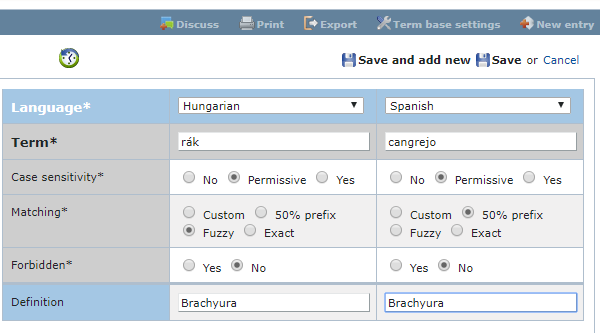New entry
You can add new entries to the term base in this pane.
How to get here
- Open memoQWeb in a web browser. Log in as an administrator, project manager, terminologist, or external user.
- Click the QTerm tab. The QTerm - Home page appears.
- Click the term base you want to browse.
- When opening a term base for the first time, a language selection flyout appears.
Choose languages from the First language and Second language dropdowns.
If you want to open this term base always with the same filter, choose it from the Filter dropdown.
- Click Browse term base. The Browse terms page opens.
- In the top right corner, click New entry. The New entry pane opens:

What can you do?
To add a new entry:
- In the Language row, select two languages.
- In the Term row, type the terms in the selected languages.
- In the Case sensitivity row, tell QTerm how to handle differences in lower- and uppercase letters when matching this term. Possible values are:
- Yes: The term is case-sensitive. If it is "memoQ", it will not match "memoq" or "Memoq". memoQ highlights the term in the text only if it has the exact same capital or lowercase letters. Use this for abbreviations like "TBD" or "XML".
- Permissive: The term matches the text if the capital letters are the same. Lowercase letters in the term can be capitalized in the text. With this setting, the term "memoQ" will match "MEMOQ" or "MemoQ" but not "memoq" or "Memoq". This is the default setting. Use this for most proper names.
- No: The term matches the text if the only difference is in letter case. With this setting, "translation" matches "Translation", "TRANSLATION" or "TranslatioN". Use this setting for common words.
- In the Matching row, tell QTerm how to handle word variants when matching this term. Possible values are:
- Fuzzy: Use this if there are variants where the beginning of the term changes. For example, in German, the plural of "Mutter" is "Mütter". To match all variants of this term, you need the Fuzzy option.
- 50% prefix: This is the default setting. memoQ finds a word in the source text if there is an exact match for it - or when a suffix is added to it, but the term is at the beginning of the word form, and it gives at one-half of it. For example: The term "cat" is found in "cats", but not in "catnapping".
- Exact: Use this if no word variants are allowed. memoQ finds a word in the source text only if there is an exact match.
- Custom: Use this to allow slight changes in the stem when a word gets suffixes. Example: Variants of the word "glorify" like "glorifies" or "glorified" are not simply suffixed forms - linguists call this "inflection". To match all forms: use a "wild card" character: "glorif|y" or "glorif*". If you enter a pipe (|) or asterisk (*) in the term, Matching automatically switches to Custom.
- In the Forbidden row, choose if the term you entered is forbidden or not.
- In the Definition row, enter a definition for the term.
Note: The Definition field is optional, but all of the above are required.
Tip: If the term base has more than two languages: Save the entry, then edit it to add the terms for the other languages.
When you finish
To save the changes and add another entry to the term base: In the upper right, click Save and add new.
To save the changes and return to the Browse terms page: In the upper right, click Save.
To not save the changes and return to the Browse terms page: In the upper right, click Cancel.
To return to the QTerm - Home screen: At the top left, click QTerm - Home.
To sign out of QTerm: In the top row, click Sign out.